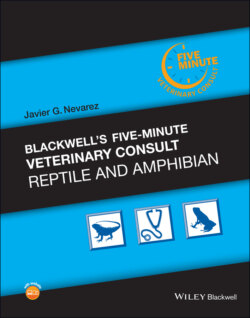Читать книгу Blackwell's Five-Minute Veterinary Consult: Reptile and Amphibian - Javier G. Nevarez - Страница 33
UVB LIGHT AND VITAMIN D3
ОглавлениеUltraviolet light is electromagnetic radiation that exists in three main bands: UVA, UVB, and UVC. Each band is characterized by a specific wavelength. UVA has the longest wavelength at 320‐400nm while UVB has a wavelength of 290‐320nm. Both UVA and UVB have low tissue penetration with most light being absorbed at the epidermis. UVA has a wavelength of less than 290nm, the deepest penetration, and is the most harmful. These wavelengths place ultraviolet somewhere between visible light (369‐769nm) and X‐rays (0.01‐10nm). The ozone layer is responsible for filtering the majority of UV radiation hence protecting living organisms from its harmful exposure. UVC is considered germicidal and can have significant harmful effects to living animals while both UVA and UVB have therapeutic and physiologic applications. Still, as we know from human medicine, too much sun/ultraviolet exposure has a slew of negative implications ranging from sunburn to premature aging, and cancer.
UVB light is essential for the synthesis of vitamin D3. Although commonly referred to as a vitamin, D3 is actually a hormone. UVB light from the sun stimulates conversion of 7‐dehydrocholesterol to cholecalciferol (D3) in the skin. Cholecalciferol is then transported to the liver via the blood stream and hydroxylated into 25‐hydroxycholecalciferol (calcidiol), which is then transported to the kidneys for hydroxylation into 1,25‐dihydroxycholecalciferol(calcitriol), the active form of D3. The 25‐hydroxycholecalciferol in the liver is the storage form of D3 and is a natural source of D3 for animals fed whole prey. Plants are a source of ergocalciferol or ergosterol (D2), which is not readily bioavailable to most reptiles and is therefore not an appropriate source of D3 supplementation. Calcidiol, an animal source of D3, is more bioavailable for reptiles.
There are two main sources of UVB, natural sunlight and UVB bulbs. Exposure to natural sunlight is the most efficient way for reptiles to produce adequate levels of D3. However, this is often not possible year round, outside the tropics and some subtropical regions, necessitating the use of artificial UVB light sources.
